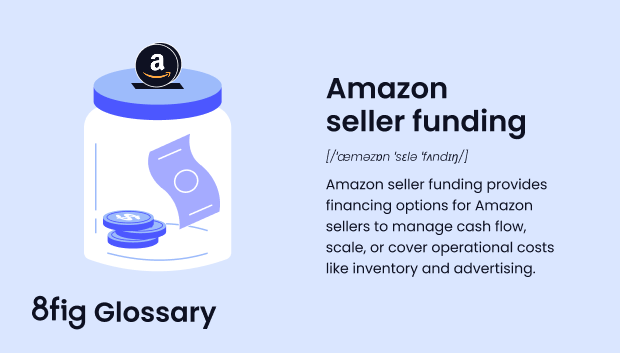Boost your cash flow with 8fig.
Definition
Amazon seller funding provides financing options for Amazon sellers to manage cash flow, scale, or cover operational costs like inventory and advertising.
What is Amazon seller funding?
Amazon seller funding refers to financial solutions tailored to address the unique needs of Amazon sellers. These funding options provide capita to help sellers manage various operational costs, including purchasing inventory, scaling advertising campaigns, covering fulfillment fees, and handling unexpected expenses like returns or seasonal spikes.
Unlike traditional financing, which often has rigid repayment schedules, Amazon seller funding is designed to accommodate the dynamics of eCommerce. For instance, many solutions align repayments with sales performance, offering flexibility during slower months. Additionally, funding providers specializing in Amazon sellers understand the platform’s specific challenges, such as delayed payouts from Amazon’s bi-weekly disbursements or the need to invest upfront for major shopping events like Prime Day or Black Friday.
Whether a seller is just starting out or scaling their business, Amazon seller funding ensures they have the resources to maintain inventory levels, optimize listings, and invest in growth opportunities without cash flow interruptions.
How it works in eCommerce
Amazon seller funding plays a vital role in the eCommerce ecosystem by addressing the unique financial hurdles faced by sellers on the platform. One of the primary challenges for Amazon sellers is the platform’s bi-weekly payout schedule, which can delay access to earned revenue. This delay can create cash flow gaps, especially for sellers who need to invest in inventory or advertising to stay competitive. Amazon seller funding bridges these gaps, ensuring sellers have access to working capital when they need it most.
Seasonal demand spikes, such as during Prime Day, Black Friday, or the holiday season, further amplify the need for quick and reliable funding. Sellers often need to purchase large quantities of inventory well in advance of these events or ramp up advertising campaigns to capture customer attention. Traditional loans may not offer the speed or flexibility required to meet these demands, making Amazon seller funding a better fit.
Unlike traditional financing, Amazon seller funding solutions are tailored to the eCommerce business model. Many providers offer flexible repayment terms that adjust based on revenue, allowing sellers to repay more during high-sales periods and less during slower months. This adaptability ensures that funding remains a tool for growth rather than a financial burden.
Additionally, Amazon seller funding can be used strategically to support long-term business goals, such as expanding product lines, entering new markets, or optimizing fulfillment strategies. By providing immediate access to capital, these solutions enable sellers to focus on scaling their businesses without being held back by cash flow constraints.
Benefits
- Flexibility: Many Amazon seller funding options, such as revenue-based financing, adjust repayments according to sales. This ensures sellers can manage their financial obligations more comfortably, especially during slower months or off-seasons.
- Quick access: Unlike traditional loans that may take weeks or months to process, Amazon seller funding often has streamlined approval processes. Sellers can secure capital quickly, making it easier to act on urgent needs like restocking inventory or ramping up marketing during peak sales periods.
- Tailored solutions: These funding options are specifically designed to address the unique cash flow challenges of Amazon sellers. Providers often understand the nuances of eCommerce, such as delayed payouts or the need to invest heavily before key shopping events.
- Growth support: Access to funding allows sellers to scale their operations, expand product lines, or explore new markets. For example, a seller might use funding to launch a new product category or optimize listings to improve conversions.
- No collateral required (in some cases): Many Amazon seller funding solutions do not require physical assets as collateral, relying instead on sales performance and business data for eligibility. This makes it accessible to more sellers.
Challenges
- Higher costs: Funding options like merchant cash advances or revenue-based financing often come with higher fees or interest rates compared to traditional bank loans. Sellers must weigh the benefits of quick access to capital against the total cost of borrowing.
- Eligibility requirements: Some funding providers may require a consistent sales history, minimum revenue thresholds, or specific metrics like seller ratings to qualify. This can be a barrier for newer sellers or those experiencing fluctuating performance.
- Repayment pressure: While flexible, repayment schedules tied to sales can become challenging if revenue drops unexpectedly due to market conditions, competition, or other factors.
- Limited funding amounts: For small or new sellers, the funding amount might be restricted based on current sales performance, potentially limiting growth opportunities.
- Over-reliance on funding: Frequent use of funding solutions to cover operational costs can lead to financial dependency, reducing overall profitability and growth in the long term.
Might also interest you:
Examples and use cases
- Preparing for peak sales events: An experienced Amazon seller specializing in electronics uses funding to stock up on high-demand items ahead of Prime Day. By analyzing past sales trends, they anticipate a 40% increase in sales during the event. The funding not only helps them avoid stockouts but also allows them to negotiate bulk discounts with suppliers, boosting their profit margins. After the successful event, they repay the funding using a portion of their increased revenue while retaining enough profit to reinvest in their business.
- Launching a new product line: A small Amazon merchant focused on home décor secures funding to introduce a new product line of sustainable, handmade goods. They use the funds to cover manufacturing costs, product photography, and an initial advertising push. The campaign generates buzz, attracting eco-conscious customers and increasing their overall brand visibility. The flexibility of revenue-based financing allows them to adjust repayments as the new line gains traction.
- Recovering from seasonal slumps: An Amazon fashion retailer experiences a dip in sales after the holiday season. To bridge the cash flow gap and prepare for the upcoming spring collection, they access funding to replenish inventory and optimize their product listings with updated keywords and professional images. This investment results in a steady increase in traffic and sales, positioning them for a strong seasonal rebound.
- Scaling advertising for competitive categories: A new Amazon merchant selling fitness equipment enters a competitive category and struggles to gain visibility. They secure funding specifically for a PPC (Pay-Per-Click) campaign, targeting high-intent keywords and leveraging sponsored product ads. The campaign doubles their traffic within two months, pushing their product to the top of search results and significantly boosting sales.
- Expanding to international markets: An established Amazon seller in the U.S. decides to expand to the European marketplace. They use funding to cover international shipping, localization of listings, and compliance with VAT regulations. The move results in a 25% increase in total revenue within six months, proving the value of the investment.
Pro tip
Use funding strategically to maximize returns. Focus on revenue-generating activities, such as restocking high-demand items before key shopping events like Prime Day or Black Friday. For example, securing capital to purchase inventory at bulk discounts can boost profit margins while ensuring you avoid stockouts during peak sales periods.
Additionally, allocate funds for targeted ads, such as Amazon PPC campaigns, to increase visibility and drive sales in competitive categories. Always compare providers to find terms that align with your cash flow and growth goals.



